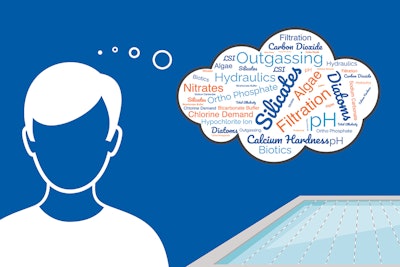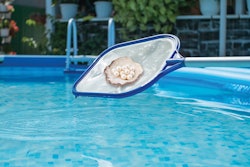
The inner workings of a pool maintenance pro's mind are not something you can see from the outside. Their actions do not appear to be different from any other pool tech that has ever altered water chemistry, adjusted circulation, or netted leaves from a pool. It’s not something you would pick up on unless you started asking questions about their method. But understand, the pro and the novice or journeyman are not the same.
The maintenance pro looks at the pool like a chess player looks at the board. It’s not just about trying a move and waiting to see what your opponent does next. Pros are thinking five to 10 moves ahead. This requires tremendous knowledge about the game, a highly skilled analytical personality, strategic skills, and the ability to peek into the future (reaction prediction). It sounds like a lot, but for maintenance pros, it is their natural process.
A maintenance pro uses decomposition more than the average pool tech, taking each problem and drilling down into smaller sub-problems in general maintenance, troubleshooting, or preventative water chemistry. This enables the pro to get to the root of the issue and offer a more permanent solution.
It takes time to get there, to see past the surfaces and through the water. The process always begins with questions — with a new employee asking why something is done a certain way. For you pros and pool care veterans, try not to take offense to that when it occurs. The soon-to-be pro is not questioning you or your method; instead, they are attempting to learn it. You are the resident expert, and they have a thirst for knowledge. Understanding why things are done a certain way helps them understand cause and effect. Don’t forget that you, the maintenance pro, are a student yourself and always will be.
But even as a student of the pool maintenance establishment, the pro is known to buck the status quo. Not to be insubordinate or disruptive, but with a desire to ultimately help the industry to a greater understanding of the subject. To help build the sacred guild of the pool maintenance pro, you must challenge it.
We’ll talk about pro philosophy again in a future column, but let’s get down to business. AQUA suggested I should get into a practical, real-world scenario, so I picked a leafy public pool. Some of you have large commercial accounts, and it’s an interesting case study even if you don’t.
Turning off the pump will actually help you start cleaning the pool, because it causes a reverse flow in the plumbing due to sudden pressure loss. This is temporary, but will fill the perimeter overflow gutters with water, and allow the water reverse flow to dislodge debris caught in the gutter grates, eliminating the need to bend over and ‘pick’ leaf matter out of each, one by one.
APPROACH TO A LEAFY PUBLIC POOL
1. Turning off the pump will actually help you start cleaning the pool, because it causes a reverse flow in the plumbing due to sudden pressure loss. This is temporary, but will fill the perimeter overflow gutters with water, and allow the water reverse flow to dislodge debris caught in the gutter grates, eliminating the need to bend over and ‘pick’ leaf matter out of each, one by one.
2. Brushing the tile line at this point will set adrift any debris stuck to the glass.
3. The gutters now contain enough water that a leaf net can quickly remove the dislodged evicted grate schmutz, and the leaf fall that has occupied the gutters. This will ultimately send some leaves over the edge and down to the pool floor while simultaneously jettisoning more outward across the surface.
4. The next step is to net the leaves from the pool surface. The netting action will ultimately cause some floating leaves to sink to the pool floor.
5. Conduct the water test now, allowing time for the sinking leaves from the past steps to settle on the bottom.
6. With all leaves now removed from the gutters and the surface, vacuum leaf debris that had accumulated on the bottom.
7. As there is no more schmutz to stir up, we brush the pool walls.
(Obviously, in these steps, you’re using hydraulics and gravity to your advantage as much as possible. They are tools in your toolbox, and you don’t even have to carry them.) This process ensures no task needs repeating by following the flow of leaves from the gutters across the surface to the floor. While it may be simple or amusing to some, depending on the breadth of leaf fall, following these steps can save the pool pro 10 to 15 minutes per pool. On a route of 10 pools, time saved can be 2 1/2 hours per day or more.
PROCEED TO BALANCING TO LSI
Here, the behind-the-scenes, or more accurately between-the-ears work involves mapping out multiple moves on the draughtboard. We know the Langelier Saturation Index (LSI) only relates to the protection of the vessel. However, the individual measures of the five factors involved in this calculation (pH, Carbonate Alkalinity, Calcium Hardness, Temperature, and Total Dissolved Solids) have the potential to catalyze or promote other less desirable conditions.
Understand that there are things we can control and things we cannot.
We need to identify the parameters we cannot control because this will dictate the adjustment we make to the parameters we can. Therefore, testing the fill water periodically is a must. Unfortunately, the water may contain things we do not test for that can also play a role. This is where we refer to the municipality’s most recent water quality report.
For example, it is common to see a level of silicates and nitrates. Many municipalities add silicates and orthophosphate as corrosion inhibitors, especially in areas with older piping. A layer of silica will not only coat those nasty old lead pipes used to route your drinking water, but it will also promote calcium silicate scaling in your pool and should realistically be a factor we include in the LSI calculation. Calcium silicate forms much more slowly, is a bit grayish, and is much more difficult to remove.
ACID TEST: Aside from the grayish vs. white color difference, a few drops of muriatic acid will quickly distinguish calcium carbonate from calcium silicate. The acid will cause the carbonate in calcium carbonate to ‘fizz’ as CO2 generates, and silicate will have no such reaction.
You can limit the potential of calcium silicate formation by maintaining a silica level of less than 150 ppm. Similarly, you can restrict calcium phosphate formation by maintaining phosphate levels of 500 ppb or lower.
Unfortunately, like the metals coming into the pool via the fill water, the silica level will only increase over time. This also increases the probability of mustard algae (diatom) colonization.
Diatoms/mustard algae are the only creatures on the planet that consume silicates, which they use to create their glass-like cell walls. As we cannot easily control the silicate level, phosphate reduction is more critical for algae control when silicates are present because it’s something algae needs to grow that we can control.
If we can only manipulate the level of one out of the three things that create an inviting environment for algae (silicates, nitrates, phosphates), we should strongly consider it.
We can also help fight algae by examining other algae needs. pH is a huge factor, and although pros can balance the LSI with pH on the high side of acceptable, they take into account that freshwater algae thrive in that environment. In fact, the closer you get to a pH of 8.2, the more inviting to algae the water becomes. This has nothing to do with chlorine’s effectiveness; of course, it is not a guarantee that the pool will be problematic. However, the pool will be more prone to algae colonization when the pH is 7.6 or greater, so one of the best preventative measures against algae is to balance the LSI with a pH of 7.5 or lower.
The pro must also consider the effect of a higher pH on the UV degradation of chlorine. You will have more hypochlorite ions at the higher end of the acceptable pH range than hypochlorous acid.
The hypochlorite ion has no attraction to cyanuric acid (CYA); therefore, CYA offers no protection. As the sun rises, the hypochlorous acid molecule forms bonds with cyanuric acid, and the hypochlorite ion concentration quickly diminishes due to solar degradation. You lose chlorine faster at a pH on the higher side of the acceptable range than at a pH of 7.5 or lower. This is yet another factor in determining the measure of pH the pro will want when balancing the index.
Finally, we have to consider the role of calcium in algae growth. Calcium saturation is what the saturation index is all about, and its presence in water is also vital for diatom colonization. These little ‘silica eaters’ use the calcium in the water for mobility. The ability to move, albeit extremely slowly, enables the algae to move to locations in the swimming pool where the conditions are most desirable. If you thwart its ability to move, you will significantly lessen its ability to thrive. The optimum Calcium Hardness level to slow diatom mobility 200 ppm, the level of Diatoms (mustard, brown, yellow, whatever you like to call it) likes best is 277.25 ppm or higher.
LET’S NOT COMPLICATE THINGS!
The method does sound tedious. Even as I write this down, I think this is a lot. But it’s not, once you wrap your mind around the fact that everything you do to a swimming pool, chemical or otherwise, changes what you want to change, but also affects two or more other things in that body of water.
It takes us back to that chessboard and predicting the opponent’s reactions in every decision before you let go of that piece. Once you understand how all your pieces move, the tactics, and the rules of the game, these decisions are made quickly, and the pool maintenance pro’s actions poolside become as easy as a life-long swimmer taking another lap.
It’s all about whole-picture assessment and treatment. How about you? Every pro has his or her own way of thinking about pools — let’s get the discussion started right here in these pages of AQUA. Put some coffee on and email me at: [email protected].
This article first appeared in the March 2023 issue of AQUA Magazine — the top resource for retailers, builders and service pros in the pool and spa industry. Subscriptions to the print magazine are free to all industry professionals. Click here to subscribe.












































